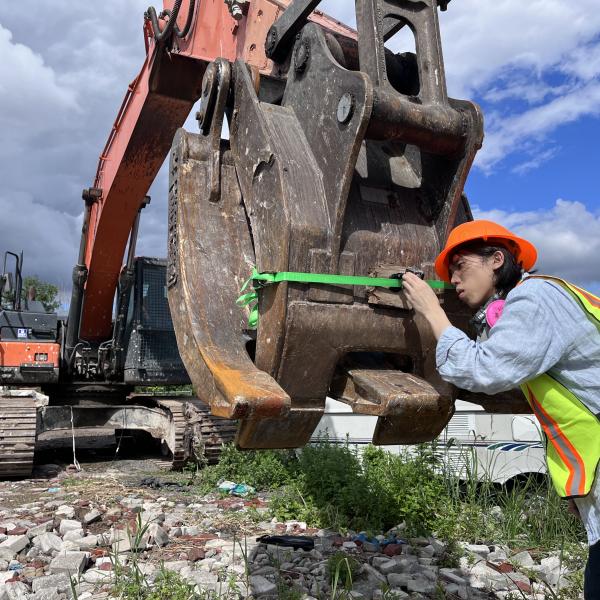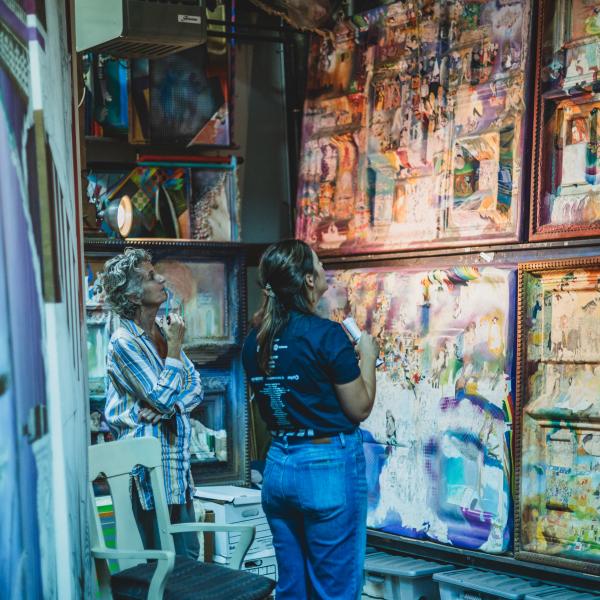Enhancing Environmental Consciousness

Condado community members work on Mural con conciencia, led by one of Estuario’s artists-in-residence, Angelica Rivera. Photo courtesy of Estuario
How can an artist-in-residence program work to support water restoration and climate resilience efforts? That’s the question at the heart of a new program by the U.S. Environmental Protection Agency (EPA) in partnership with the NEA. As announced by then-assistant EPA Office of Water administrator Radhika Fox at the January 2024 event Healing, Bridging, Thriving: A Summit on Arts and Culture in our Communities, co-hosted by the White House Domestic Policy Council and the NEA, EPA is launching its first-ever artist-in-residence program. The initiative embeds artists within six national estuary or urban water locations with the goal of integrating arts and culture into key EPA program areas. Fox noted that this program will “unleash the power of arts and culture to support water restoration and climate resilience efforts around the country.”
EPA is allocating up to $200,000 to each of the selected locations to support the artists' residencies for 18 months to increase community issues, building better understanding of water quality concerns and stronger connections between communities and natural resources. Participating locations are the Passaic River and Bronx and Harlem River in New York and New Jersey, Greater Philadelphia area/Delaware River Watershed in Pennsylvania, Green-Duwamish Watershed/Puget Sound in Washington, Middle Rio Grande/Albuquerque in New Mexico, Mystic River Watershed/Massachusetts Bay in Massachusetts, and San Juan Bay Estuary in Puerto Rico.
As a partner with EPA in the initiative, NEA is providing participating locations with guidance around practical aspects of the program, like crafting calls to artists and getting the word out, as well as inspiration around the role of artists in community-engaged work. Both agencies intend to document learnings and successes out of the pilot, with an intent to share insights and encourage wider adoption across federal government.
In Puerto Rico, the artist residency is focusing on the San Juan Bay Estuary, which extends through eight municipalities, from the mountains of San Juan to the coast between Toa Baja and Loíza. An estuary is a coastal area into which freshwater from a river flows and mixes with saltwater from the ocean in bays, lagoons, and canals, creating a unique ecosystem where a variety of wildlife species live. The San Juan Bay Estuary ecosystem supports 17 plants and eight animal species facing extinction, such as the Antillean manatee, as well as 19 species of reptiles and amphibians, 124 species of fish, 300 species of wetland plants, and is the habitat of at least 11 of the 17 native birds of Puerto Rico. Outside of the enormous ecological value, the estuary is also important economically to the territory. It is a major port for Puerto Rico, where 80 percent of products arrive, including the majority of the island’s food supply. It is also a source of tourist income for the island. Keeping the estuary both clean and sustainable is of the utmost importance to Puerto Rico.
The San Juan Bay Estuary Partnership, or Estuario, is a nonprofit in Puerto Rico whose mission is to improve water quality and ecosystems in the San Juan Bay Estuary, and they will work with the EPA and NEA on the artist-in-residence program there. Estuario has been running an artist-in-residence program since 2018 with funding from EPA’s Office of Water as part of the National Estuary Program. The residency program started after the hurricanes Irma and Maria hit the island in 2017 as a way to reconnect communities with their ecosystems. “Resident artists immerse themselves into a particular community and produce a piece communicating how the community’s interests and needs relate to a project,” said Brenda Torres Barreto, executive director of Estuario. “These kinds of engagement enhance environmental consciousness and facilitate community engagement in developing a resilient watershed.”

A section of the Juan Méndez Creek in San Juan, Puerto Rico, the location for one of the EPA/NEA artist residencies. Photo courtesy of Estuario
For this new EPA/NEA initiative, Estuario is looking for artists to work with the community around the Juan Méndez Creek, which begins near the state urban forest and flows through low-income communities in San Juan before finally draining into the San José Lagoon. The creek was channelized in the 1950s to accommodate San Juan’s urban sprawl and control flooding in low-lying areas, but today it is impacted by sanitary discharges and structural deficiencies that pose a threat to surrounding communities during flooding episodes, affecting approximately 51,000 people.
The artist-in-residence project will, according to Torres Barreto, “not only generate awareness but also foster the creation of a community-based identity surrounding this important asset.” She added, “The goal is to steward long-term support and engagement with the Juan Méndez Creek restoration project. Given that this project is in its initial stages, Estuario hopes an engagement strategy through arts and culture will help educate the community and make stakeholders aware of the importance of addressing environmental and social justice through resilient infrastructure.”
The proposed residency project will be carried out in close collaboration with the Juan Méndez Creek communities as well as stakeholders responsible for managing the natural resources and water infrastructure of the region, such as the Municipality of San Juan and the Puerto Rico Department of Transportation and Public Works. “The artist’s project should promote climate resiliency awareness, equity/cultural preservation, and water quality in the Juan Méndez Creek restoration project context,” Torres Barreto said.
Estuario has seen success in previous artist residencies that it has supported. “Each project offers different strategies and artistic products based on the artist, the communities, and the issues being addressed in the community/region by Estuario,” Torres Barreto noted. “Success is measured through community engagement, the number of residents and community institutions, presentations, workshops, and artist productions.”

An Estaurio artist residency included sessions on how to artistically reuse glass that was discarded and discussed the importance of recycling glass materials for the community’s environment. Photo courtesy of Estaurio
Estuario has engaged with ten artists since it started the program, working with communities in five areas of the San Juan Bay Estuary watershed. In one project in the Machuchal community of Santurce, the artist Michelle Malley led sessions on how to artistically reuse glass that was discarded and discussed the importance of recycling glass materials for the community’s environment. Held in the Taller Comunidad La Goyco, a community cultural space, the workshops spotlighted the community’s habits regarding the consumption and disposal of glass. Another project in the Condado Lagoon area aimed to raise awareness about the protection of the lagoon habitat. The artist, Angelica Rivera, led the community in the conceptualization and creation of a mural located at the Rowing Federation building in Jaime Benítez Park. The artist also taught art and drawing workshops with community members.
Visual artists were not the only ones who participated in the program. Musician Armando Román investigated the sounds of San Juan Bay Estuary ecosystem and their relationship with the surrounding populations. Román interviewed community members to explore their sound memories and created field recordings inspired by those interviews, leading eventually to a final sound installation. The artist wanted to both bring attention to the noise pollution in the estuary ecosystem as well as emphasize the beauty of the natural sounds of the environment. To achieve this, Román carried out sound documentation tours in Monagas, Parque Central, and the Piñones State Forest with assistance from community volunteers, as well as additional solo tours in other areas of the estuary. A selection of these recordings is available on Bandcamp for streaming and downloading.
Torres Barreto sees these artist residency projects as essential to Estaurio’s engagement process, helping communities especially in the aftermath of calamities such as hurricanes, earthquakes, and the COVID-19 pandemic. “This strategy has proven to be a resilient and effective tool in times of crisis,” she stated.
A Request for Proposals for the EPA/NEA-supported artist residency at Juan Méndez Creek has been advertised. Torres Barreto believes the project will bring communities and sectors together artistically. “With this hefty support,” she said, “we expect to obtain a firm proposal from a cadre of artists or an artist who brings out-of-the-box ideas and truly brings the community together about issues that are otherwise not understood by the general public.”
If the EPA/NEA artist-in-residence initiative shows success, there is consideration for expanding it beyond the six regions nationwide. At the very least, the imagination and innovation the artists bring to water restoration projects and their communities in these regions will be immense. As Fox noted at the summit, “I cannot wait to see what creativity, what new solutions, what new ways of thinking and being together will develop through these partnerships.”








